|
|
Swami Samarth Origin, Life & Samadhi Topics
|
|
Summary: Shri Swami Samarth
|
Shri Swami Samarth (also called Sri Akkalkot Swami Samarth) is considered as extension of the fifteenth century incarnation of
Lord Dattatreya, namely Shrimad Narasimha Saraswati.
It is mentioned in the holy book of Shri Gurucharitra that Shrimad Narasimha Saraswati entered into mahasamadhi in Kardalivana in 1458. He stayed in Samadhi for over 300 years and emerged from samadhi because a woodcutter accidentally cut through a tree and hit Shrimad Narasimha Saraswati (or Sri Swami Samarth).
This awakened Shrimad Narasimha Saraswati from the prolonged samadhi. That divine personality is now known as Shri Swami Samarth. After emerging from samadhi Shrimad Narasimha Saraswati (Shri
Swami Samarth) traveled all over the country.
Two Stories of origin, manifestation or appearance (arrival on the earth) of Shri Swami Samarth

|
|
|
|
Origin: Shrimad Narasimha Saraswati (Lord Dattatreya incarnation of the Divine Trinity Brahma, Vishnu and Mahesh-Shiva: 1378 −1458)
|
Shrimad Narasimha Saraswati (1378 −1458) is the Purna Avatar of Lord Dattatreya (As per "Shripad Shrivallabha Charitra" he is second avatar of Lord Dattatreya).
In a place called Karanja Nagar which is modern Lad-Karanja or karanja (Maharashtra Vidbaraba region, there lived a pious Brahmin couple, Madhava and Ambabhavani, in the 13th century. Shrimad Narasimha Saraswati was born to this God-fearing & religious couple.
The child (Narasimha Saraswati) was unique in the sense that, he was chanting only 'Aum' (OM - the Hindu holy nirgun mantra) since his birth. However, until he was 7 he did not utter any other word other than OM, so his parents were worried about his speech ability. However, he showed by hand gestures that after his Upanayana (Munja - Bratabandha or the sacred thread bearing ceremony) he will be able to speak.
In fact after his munja was performed he was able to speak all the holy Vedas (the Holiest Hindu scriptures) and even started delivering lectures on it. This was remarkable for a 7 year old child and many senior learned Brahmins in the village started coming to him for learning the Vedas to the great astonishment of all the learned people.
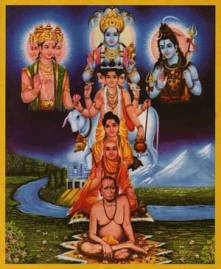
Shrimad Narasimha Saraswati (Lord Dattatreya incarnation
of the Divine Trinity Brahma, Vishnu and Mahesh-Shiva)
|
Shrimad Narasimha Saraswati stayed at Ganagapur for a long time. He performed many miracles during his stay to help his devotees. After a visit with a Muslim king (Sultan) of Bedar (also explained in Shree Gurucharitra - who is possibly Allauddin-II of the Bahamani Sultanate) Shrimad Narasimha Saraswati decided to leave to Kardali forests to perform Tapasya (penance.)
Shrimad Narasimha Saraswati gave his "Nirgun Padukas" to his disciples and devotees, before leaving for the Kardali forests for his tapasys. Shrimad Narasimha Saraswati’s disciples prepared a floating seat of flowers for him on which he sailed against the current of the river Patalganga and disappeared in Kardali forests.
A learned ascetic named Shree Krishna Saraswati Swami, initiated Narasimha Saraswati into Sanyasashram (Asceticism – described as a lifestyle characterized by abstinence from various sorts of worldly pleasures often with the aim of pursuing religious and spiritual goals) and gave him the name, Shrimad Narasimha Saraswati.

|
|
Shrimad Narasimha Saraswati: Rigorous Penance, Pilgrimage, Guidance to devotees
|
Shrimad Narasimha Saraswati performed rigorous tapasya (penance) on the Shree Shail mountain in the Kardali forests for nearly 150 years. After this he took an extensive pilgrimage, covering many places, now known as Jawa, Sumatra, Indonesia, China etc., relieved many people from their miseries, and guided them on the spiritual path.
Finally, he came to the ranges of Himalayas where he enlightened many devotees. Later he sat under a Deodar tree for another tapasya (penance). This Tapasya (penance) in the Himalayas lasted for nearly 250 years, but a woodcutter unknowingly axed the anthill enveloping the body of Shrimad Narasimha Saraswati. This resulted in the break in Tapasya and Shrimad Narasimha Saraswati then left for an extensive travel throughout the Indian sub-continent guiding his devotees.
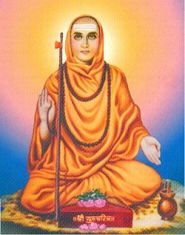
Shrimad Narasimha Saraswati |

|
|
Shree Gurucharitra:
Biography of Narasimha Saraswati
|
'Shri Guru Charitra' is the life of 'Shri Guru Dattatreya' (Brahma, Vishnu, Mahesh Incarnate). This is the biography of Shrimad Narasimha Saraswati, that gives us the details of his work in guiding the devotees and the various miracles that he performed to help the devotees.
It was originally written in Marathi by one Saraswati Gangadhar, whose ancestor Sayamdeo had personally lived and served with devotion, Shri Guru Narasinha Saraswati, about 500 years ago.
This volume is regarded as a greatly divine, versatile, a blessing one and is placed with images of Gods and adored in almost all brahmins' houses. It is much respected and is very popular like Vedas, Ramayan, Mahabharat, Bhagwat and other puranas in sanskrit and Dnyaneshwari, Dasbodh, Eknathi Bhagwat etc. in Marathi. In Shri Gurucharitra Chapter 11 onwards is the description of life story of Shrimad Narasimha Saraswati.
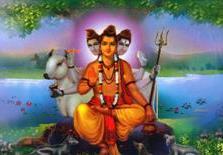
Shree Gurucharitra (Biography of Narasimha Saraswati) |
The main teaching of Shrimad Narasimha Saraswati has been that the life of Brahmins is fully covered by the rules given in the old scriptures and they are to be strictly followed by them in their daily lives to achieve happiness and ultimately moksha (the final attainment of soul where the soul is liberated from the cycle of rebirths). He insisted on his disciples to follow these routines. This improved their confidence and self esteem which was very essential at the time the attack of a foreign culture was going on. This feeling penetrating through the generations, gave a special sense of self esteem and pride which eventually resulted in the coming up of the fighters like King Shivaji and Peshwas in later years in Maharashtra. Narasimha Saraswati helped all the people from all the communities and can be seen in his life stories.

|
|
Narasimha Saraswati’s meeting
with a Muslim king Bedar |
One of the events in Shrimad Narasimha Saraswati’s life (towards the end) was the meeting with the Muslim king (Sultan) of Bedar (also explained in Shree Gurucharitra) who is possibly Allauddin-II of the Bahamani Sultanate who was ruling that area that time.
The king visited Shrimad Narasimha Saraswati because he was suffering from a blister which was not curing. No one was able to cure, so he was advised to visit Shrimad Narasimha Saraswati, and after visiting him he was cured.
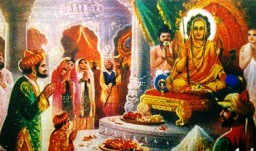
Guru Narasimha Saraswati’s meeting with a Muslim
king Bedar |
Among the Bahamani kings, only Allauddin-II is supposed to have died due to the blister as per the records of his court historians. This king was moderate and did not destroy temples or old monuments. He also was supposed to be quite friendly towards the Hindu communities.
After the meeting with the Muslim king, Shrimad Narasimha Saraswati thought that his fame has gone to such an extent that now all types of people will start coming in, and will start troubling him and his disciples. Thus he decided to take samadhi. He left for the jungle of Kardali (a type of tree).

|
|
Appearance as Shri Swami Samarth at
Akkalkot
|
Shrimad Narasimha Saraswati stayed in Samadhi and emerged from samadhi because a woodcutter accidentally cut through a tree and hit Shrimad Narasimha Saraswati (now Sri Swami Samarth). This awakened Shrimad Narasimha Saraswati from the prolonged samadhi. After emerging from samadhi Shrimad Narasimha Saraswati traveled all over the country. (The divine personality of Shrimad Narasimha Saraswati is now known as Shri Akkalkot Swami Samarth.)
During Shrimad Narasimha Saraswati’s travel, he became popular by various names at various places. Thus at one place he was known as Chanchal Bharati and at another place he would be called Digambar Swami.
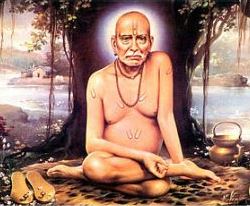
Shri Swami Samarth sitting under banyan tree, Akkalkot |
As he traveled and stayed at various places, he became the Guru (preceptor) of many great souls like Shree Ramkrishna Paramahansa, Shree Saibaba of Shirdi, Shree Shankar Maharaj, Shree Gajajan Maharaj of Shegaon etc. Finally he settled down at Akkalkot (Maharashtra State) and stayed there for 22 years from 1856 A.D. to 1878 A.D. and thus came to be known as the Akkalkot Niwasi Shree Swami Samarth Maharaj (the great sage of Akkalkot).
Here he enlightened many disciples, such as Shree Dev Mamledar, Shree Balappa Maharaj, Shree Cholappa Maharaj, Shree Nrusimha Saraswati Maharaj of Alandi, Shree Ramanand Beedkar Maharaj of Pune etc.
Therefore, Shri Swami Samarth is considered as Avatar (incarnation) of Lord Dattatreya.

|
|
Shri Swami Samarth: Stay at Akkalkot
|
Shri Swami Samarth lived for over two decades (22 years) at Akkalkot, mainly at the residence of his disciple Cholappa, where his Samadhi and shrine are now located. The shrine complex, The Vatavruksha Mandir, which also encloses the banyan tree beneath which the Swami would preach his message, is the hub of devotions for his followers; free accommodation and meals are provided to pilgrims by Shri Swami Samarth Annachhatra Mandal also.
The other shrine is of Samadhi of Swami located at some distance from the main shrine.
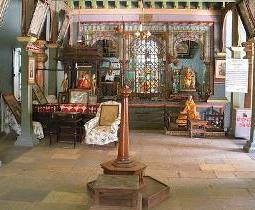
Gurumandir of Swami Samarta, Akkalkot |

|
|
Life and teachings of Shri
Swami Samarth
|
Sri Swami Samarth was an epitome of wisdom and knowledge and is considered an Avadhoot: Maha-Yogi possessing great spiritual powers.
He was always muttering mystic 'Mantras' or words that very few could understand. He expressed oneness with all creations. The splendor of Shri Swami Samarth and his glorious mission became more fully manifest, after his arrival in town of Akkalkot in Maharashtra.
Sri Swami stayed in Akkalkot, for 22 years till his Mahasamadhi, showing the common man the path to the God. Swami Samarth is known to have performed several miracles for his devotees.
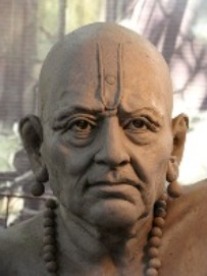
Life and teachings of Shri Swami Samarth |

|
|
Mahasamadhi
|
On April 30, 1878 (Chaitra Vadya Trayodashi of Hindu year 1800) after nearly 600 years of the incarnation, the great sage adopted Mahasamadhi (the last conscious communion with God) under his favorite Banyan tree.
His spiritual powers are experienced by devotees even now. Flow of pilgrims continues to Akkalkot every year. Those who go there for darshan of the samadhi, still feel the subtle powers of akkalkot swami samarth. They feel a definite response to their prayers. Some are healed of their sufferings and others find their desire fulfilled. Even though Shri Swami Samarth is no longer in his bodily manifestation, He continues to guide his devotees.
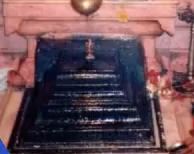
Samadhi: Shri Swami Samartha, Akkalkot |
Devotees still experience his divine presence and feel reassured because of his quote "I have not gone, I am still present" (“Bhiu nako me tuhya pathishi ahe” in Marathi)

|
|
Mantras of Shri Swami Samarth
|
Sagun mantras are the mantras that represent and invoke a particular a Deity, God, Saint or Guru by praising the qualities to attain self-realization. Sagun Mantras form visual patterns upon repeated chanting until this chanting gives rise to the real form of deity or saint (or call it a visualization)
Shri Akkalkot Swami Samarth devotees sing many mantras of Swami Samarth. In one of Swami Sut (Swami Bhakt at Mumbai) abhang (devotional poetry sung in praise of the Lord Vitthala also known as Vithoba) says Shri Swami Samarth mantra is "Swami Samarth".
Another abhang says His mantra is "Shri Swami Samarth Jai Jai Swami Samarth" (This is one of the most popular mantras of Swami Samartha)
In Swamiji's Holi Books, it is mentioned that His bhakt Ballappa had used the six lettered mantra "Shri Swami Samarth"
Swami Samarth: Mantra, Bhajan, Aartis, Jaap, Naam: Video Collection

Swami samarth: "Tu Bhiu nakos me tuhya pathishi
ahe" |

|
|
|
|
|
|